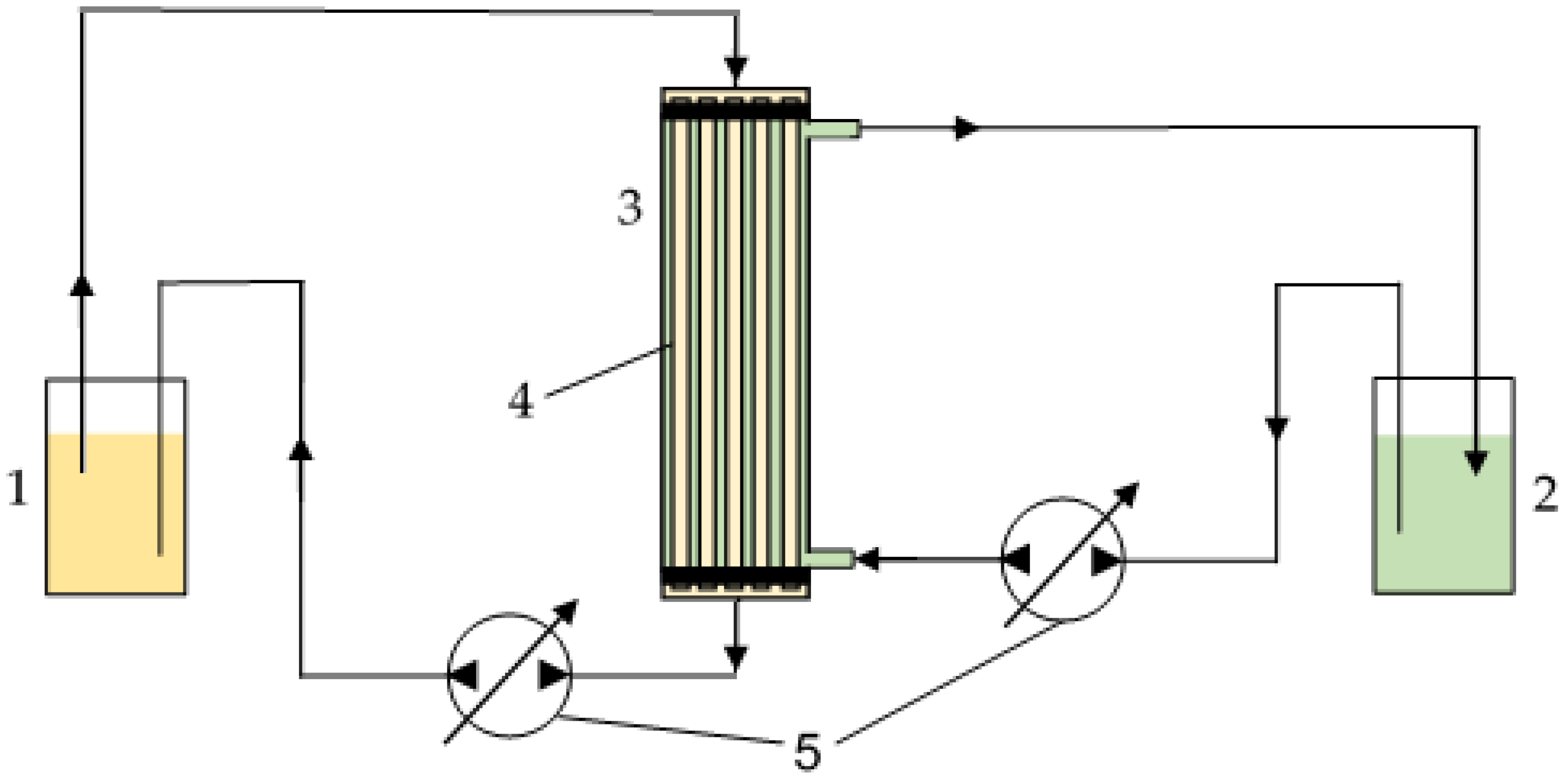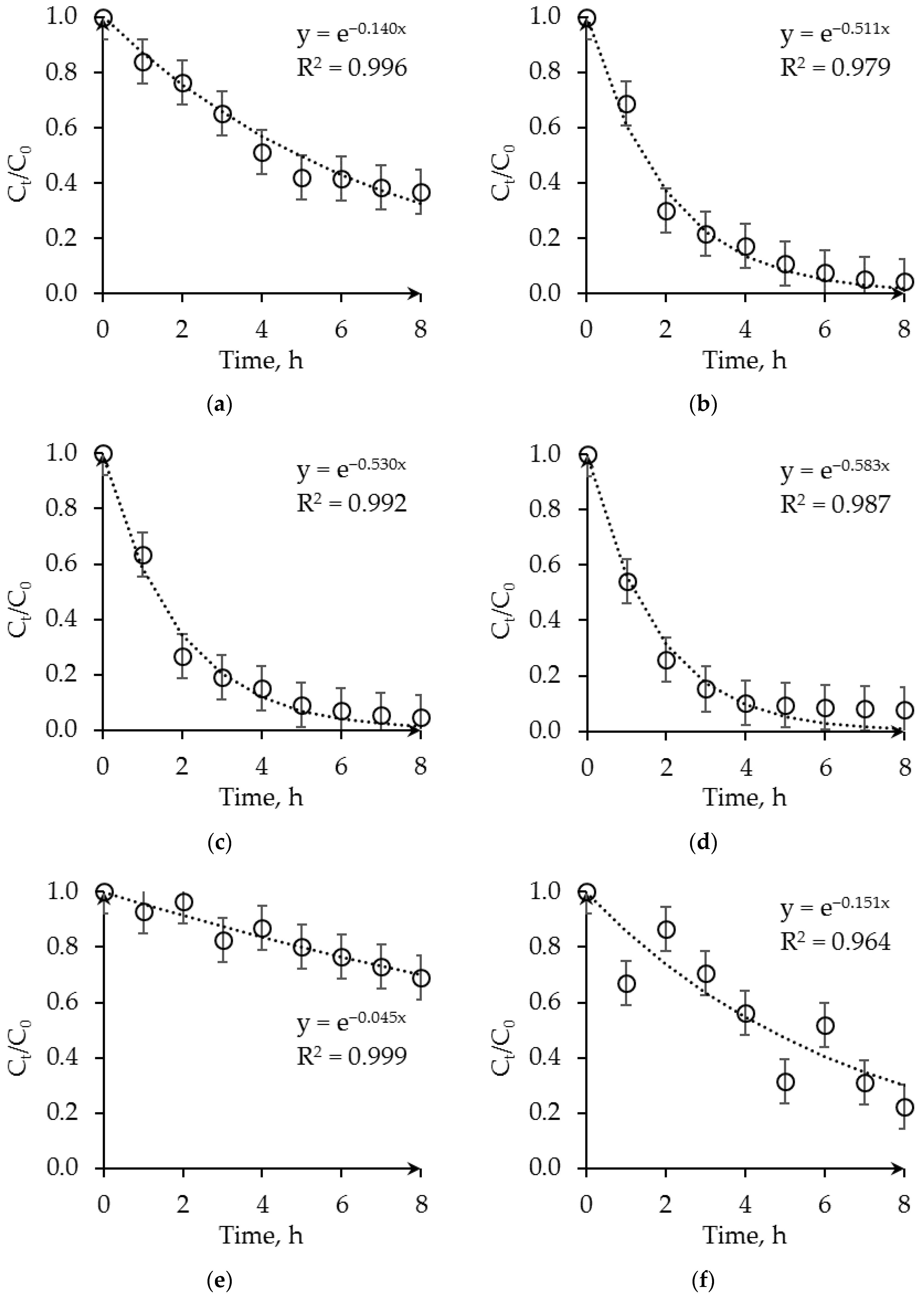Reclaiming of Amine CO2 Solvent Using Extraction of Heat Stable Salts in Liquid-Liquid Membrane Contactor
Abstract
:1. Introduction
2. Materials and Methods
2.1. Materials and Reagents
2.2. PSF Hollow Fiber Membranes Preparation
2.3. Membrane Characterization
2.4. Lab-Scale Extraction Experiments
3. Results and Discussion
3.1. PVDF and PSF Hollow Fibers Characteristics
3.2. Extraction of HSS in Liquid-Liquid Hollow Fiber Membrane Contactor
4. Conclusions
Author Contributions
Funding
Institutional Review Board Statement
Informed Consent Statement
Data Availability Statement
Acknowledgments
Conflicts of Interest
References
- Hansen, J.; Johnson, D.; Lacis, A.; Lebedeff, S.; Lee, P.; Rind, D.; Russell, G. Climate Impact of Increasing Atmospheric Carbon Dioxide. Science 1981, 213, 957–966. [Google Scholar] [CrossRef] [PubMed]
- Bazhenov, S.; Chuboksarov, V.; Maximov, A.; Zhdaneev, O. Technical and economic prospects of CCUS projects in Russia. Sustain. Mater. Technol. 2022, 33, e00452. [Google Scholar] [CrossRef]
- Gür, T.M. Carbon Dioxide Emissions, Capture, Storage and Utilization: Review of Materials, Processes and Technologies. Prog. Energy Combust. Sci. 2022, 89, 100965. [Google Scholar] [CrossRef]
- Kohl, A.; Nielsen, R. Gas Purification, 5th ed.; Gulf Publishing Company: Huston, TX, USA, 1997; 1414p. [Google Scholar]
- Rochelle, G.T. Amine scrubbing for CO2 capture. Science 2009, 325, 1652–1654. [Google Scholar] [CrossRef] [PubMed]
- Wang, M.; Lawal, A.; Stephenson, P.; Sidders, J.; Ramshaw, C. Post-Combustion CO2 Capture with Chemical Absorption: A State-of-the-Art Review. Chem. Eng. Res. Des. 2011, 89, 1609–1624. [Google Scholar] [CrossRef]
- Rieder, A.; Unterberger, S. EnBW’s Post-Combustion Capture Pilot Plant at Heilbronn–Results of the First Year’s Testing Programme. Energy Procedia 2013, 37, 6464–6472. [Google Scholar] [CrossRef]
- Bui, M.; Gunawan, I.; Verheyen, V.; Feron, P.; Meuleman, E. Flexible Operation of CSIRO’s Post-Combustion CO2 Capture Pilot Plant at the AGL Loy Yang Power Station. Int. J. Greenh. Gas Control 2016, 48, 188–203. [Google Scholar] [CrossRef]
- Luis, P. Use of Monoethanolamine (MEA) for CO2 Capture in a Global Scenario: Consequences and Alternatives. Desalination 2016, 380, 93–99. [Google Scholar] [CrossRef]
- Yamada, H. Amine-Based Capture of CO2 for Utilization and Storage. Polym. J. 2021, 53, 93–102. [Google Scholar] [CrossRef]
- Borhani, T.N.; Wang, M. Role of Solvents in CO2 Capture Processes: The Review of Selection and Design Methods. Renew. Sustain. Energy Rev. 2019, 114, 109299. [Google Scholar] [CrossRef]
- Aghel, B.; Janati, S.; Wongwises, S.; Shadloo, M.S. Review on CO2 Capture by Blended Amine Solutions. Int. J. Greenh. Gas Control 2022, 119, 103715. [Google Scholar] [CrossRef]
- Buvik, V.; Høisæter, K.K.; Vevelstad, S.J.; Knuutila, H.K. A Review of Degradation and Emissions in Post-Combustion CO2 Capture Pilot Plants. Int. J. Greenh. Gas Control 2021, 106, 103246. [Google Scholar] [CrossRef]
- Gouedard, C.; Picq, D.; Launay, F.; Carrette, P.-L. Amine Degradation in CO2 Capture. I. A Review. Int. J. Greenh. Gas Control 2012, 10, 244–270. [Google Scholar] [CrossRef]
- Choi, Y.S.; Duan, D.; Nesic, S.; Vitse, F.; Bedell, S.A.; Worley, C. Effect of oxygen and heat stable salts on the corrosion of carbon steel in MDEA-based CO2 capture process. Corros 2010, 66, 125004. [Google Scholar] [CrossRef]
- Supap, T.; Saiwan, C.; Idem, R.; Tontiwachwuthikul, P.P. Part 2: Solvent management: Solvent stability and amine degradation in CO2 capture processes. Carbon Manag. 2011, 2, 551–566. [Google Scholar] [CrossRef]
- Wu, X.; ElMoudir, W.; Aboudheir, A.; Mahinpey, N. Reclaiming degraded mixed monoethanolamine and N-methyldiethanolamine solvent in carbon dioxide capture process. J. Nat. Gas Sci. Eng. 2022, 95, 104214. [Google Scholar] [CrossRef]
- Bayati, B.; Mirshekari, M.; Veisy, A.; Gando-Ferreira, L.M. Removal of HSS from Industrial Amine Solution by Anionic Resin (Case Study: Ilam Gas Refinery). Chem. Pap. 2019, 73, 491–500. [Google Scholar] [CrossRef]
- Mansoori, S.A.A.; Zaherboomi, R.; Hosseinzadeh, M.; Mansoori, S.M.; Jomekian, A.; Sedaghat, S.; Ehsaninezhad, A. HSS anions reduction combined with the analytical test of aqueous MDEA in South Pars gas complex. Nat. Gas Ind. B 2022, 9, 318–324. [Google Scholar] [CrossRef]
- Bazhenov, S.; Rieder, A.; Schallert, B.; Vasilevsky, V.; Unterberger, S.; Grushevenko, E.; Volkov, V.; Volkov, A. Reclaiming of Degraded MEA Solutions by Electrodialysis: Results of ED Pilot Campaign at Post-Combustion CO2 Capture Pilot Plant. Int. J. Greenh. Gas Control 2015, 42, 593–601. [Google Scholar] [CrossRef]
- Grushevenko, E.; Bazhenov, S.; Vasilevsky, V.; Novitsky, E.; Shalygin, M.; Volkov, A. Effect of carbon dioxide loading on removal of heat stable salts from amine solvent by electrodialysis. Membranes 2019, 9, 152. [Google Scholar] [CrossRef]
- Kikhavani, T.; Mehdizadeh, H.; Van der Bruggen, B.; Bayati, B. Removal of Heat-Stable Salts from Lean Amine of a Gas Refinery via Electrodialysis. Chem. Eng. Technol. 2021, 44, 318–328. [Google Scholar] [CrossRef]
- Ghorbani, A.; Bayati, B.; Poerio, T.; Argurio, P.; Kikhavani, T.; Namdari, M.; Ferreira, L.M. Application of NF Polymeric Membranes for Removal of Multicomponent Heat-Stable Salts (HSS) Ions from Methyl Diethanolamine (MDEA) Solutions. Molecules 2020, 25, 4911. [Google Scholar] [CrossRef] [PubMed]
- Akkarachalanont, P.; Saiwan, C.; Supap, T.; Idem, R.; Tontiwachwuthikul, P. New Reactive Extraction Based Reclaiming Technique for Amines Used in Carbon Dioxide Capture Process from Industrial Flue Gases. Ind. Eng. Chem. Res. 2016, 55, 5006–5018. [Google Scholar] [CrossRef]
- Karnwiboon, K.; Krajangpit, W.; Supap, T.; Muchan, P.; Saiwan, C.; Idem, R.; Koiwanit, J. Solvent Extraction Based Reclaiming Technique for the Removal of Heat Stable Salts (HSS) and Neutral Degradation Products from Amines Used during the Capture of Carbon Dioxide (CO2) from Industrial Flue Gases. Sep. Purif. Technol. 2019, 228, 115744. [Google Scholar] [CrossRef]
- Rongwong, W.; Goh, K. Resource recovery from industrial wastewaters by hydrophobic membrane contactors: A review. J. Environ. Chem. Eng. 2020, 8, 104242. [Google Scholar] [CrossRef]
- Mansourizadeh, A.; Rezaei, I.; Lau, W.J.; Seah, M.Q.; Ismail, A.F. A review on recent progress in environmental applications of membrane contactor technology. J. Environ. Chem. Eng. 2022, 10, 107631. [Google Scholar] [CrossRef]
- Riedl, W. Membrane-Supported Liquid-Liquid Extraction–Where Do We Stand Today? ChemBioEng Rev. 2021, 8, 6–14. [Google Scholar] [CrossRef]
- Chemarin, F.; Athès, V.; Buquet, W.; Bedu, M.; Allais, F.; Teixeira, A.F.; Moussa, M.; Trelea, I.C. Predictive modeling and experimental implementation of organic acids in stream recovery by reactive extraction in membrane contactors. Chem. Eng. J. 2022, 431, 134067. [Google Scholar] [CrossRef]
- Karunanithi, S.; Kapoor, A.; Delfino, P. Separation of Carboxylic Acids from Aqueous Solutions Using Hollow Fiber Membrane Contactors. J. Membr. Sci. Res. 2019, 5, 233–239. [Google Scholar] [CrossRef]
- Cao, Y.; Nakhjiri, A.T.; Sarkar, S.M.; Ghadiri, M. Time-dependent numerical investigation of 3-hydroxypropionic acid extraction using a microporous membrane contactor. Eur. Phys. J. Plus 2022, 137, 494. [Google Scholar] [CrossRef]
- Gössi, A.; Burgener, F.; Kohler, D.; Urso, A.; Kolvenbach, B.A.; Riedl, W.; Schuur, B. In-situ recovery of carboxylic acids from fermentation broths through membrane supported reactive extraction using membrane modules with improved stability. Sep. Purif. Technol. 2020, 241, 116694. [Google Scholar] [CrossRef]
- Borisov, I.; Vasilevsky, V.; Matveev, D.; Ovcharova, A.; Volkov, A.; Volkov, V. Effect of Temperature Exposition of Casting Solution on Properties of Polysulfone Hollow Fiber Membranes. Fibers 2019, 7, 110. [Google Scholar] [CrossRef]
- Matveev, D.; Borisov, I.; Vasilevsky, V.; Karpacheva, G.; Volkov, V. Spinning of Polysulfone Hollow Fiber Membranes Using Constant Dope Solution Composition: Viscosity Control via Temperature. Membranes 2022, 12, 1257. [Google Scholar] [CrossRef]
- Matveev, D.N.; Kutuzov, K.A.; Vasilevsky, V.P. Effect of Draw Ratio on the Morphology of Polysulfone Hollow Fiber Membranes. Membr. Membr. Technol. 2020, 2, 351–356. [Google Scholar] [CrossRef]
- Yushkin, A.A.; Efimov, M.N.; Malakhov, A.O.; Karpacheva, G.P.; Bondarenko, G.; Marbelia, L.; Vankelecom, I.F.J.; Volkov, A.V. Creation of Highly Stable Porous Polyacrylonitrile Membranes Using Infrared Heating. React. Funct. Polym. 2021, 158, 104793. [Google Scholar] [CrossRef]
- Ovcharova, A.; Vasilevsky, V.; Borisov, I.; Bazhenov, S.; Volkov, A.; Bildyukevich, A.; Volkov, V. Polysulfone Porous Hollow Fiber Membranes for Ethylene-Ethane Separation in Gas-Liquid Membrane Contactor. Sep. Purif. Technol. 2017, 183, 162–172. [Google Scholar] [CrossRef]
- Baker, R.W. Membrane Technology and Applications, 3rd ed.; John Wiley & Sons: Chichester, West Sussex, UK, 2012; pp. 15–96. [Google Scholar]
- Kostyanaya, M.I.; Yushkin, A.A.; Bakhtin, D.S.; Legkov, S.A.; Bazhenov, S.D. Perstraction of Heat-Stable Salts from Aqueous Alkanolamine Solutions. Pet. Chem. 2022, 62, 1254–1266. [Google Scholar] [CrossRef]





| Parameter | Value | |
|---|---|---|
| Active fiber length, m | 0.15 | |
| Inner diameter of fiber, mm | PVDF | 1.2 |
| PSF | 1.2 | |
| Outer diameter of fiber, mm | PVDF | 2.1 |
| PSF | 1.6 | |
| Shell inner diameter, m | 0.015 | |
| Membrane surface area, cm2 | PVDF | 50 |
| PSF | 40 | |
| Packing density, m2/m3 | 200 | |
| Material | PVDF | PSF | ||
| Type | asymmetric | asymmetric | ||
| Pore size *, nm | 43 ± 5 | 10 ± 2 | ||
| P/l, m3(STP) (m2∙h∙atm)−1 | He | 1430 ± 20 | He | 6.53 ± 0.10 |
| CO2 | 640 ± 10 | CO2 | 2.22 ± 0.10 | |
| α (He/CO2) | 2.23 | 2.94 | ||
| Process | HSS Removal, % | Main Disadvantages | Ref. |
|---|---|---|---|
| Membrane-supported liquid-liquid extraction | 90–95 | Technology not yet scaled up. Difficulty in controlling the transmembrane pressure to ensure the absence of mixing of the phases | this work |
| Liquid-liquid extraction | 88–90 | Phase dispersion with long phase separation time | [24] |
| Nanofiltration | 75–80 | The need for high pressure | [20] |
| Thermal distillation | 80–95 | High energy consumption and amine losses | [17] |
| Ion exchange | 95–97 | Multistage periodic process with large volumes of regeneration chemicals | [18] |
| Electrodialysis | 90–95 | High energy consumption and amine losses at low HSS concentration | [21] |
Disclaimer/Publisher’s Note: The statements, opinions and data contained in all publications are solely those of the individual author(s) and contributor(s) and not of MDPI and/or the editor(s). MDPI and/or the editor(s) disclaim responsibility for any injury to people or property resulting from any ideas, methods, instructions or products referred to in the content. |
© 2023 by the authors. Licensee MDPI, Basel, Switzerland. This article is an open access article distributed under the terms and conditions of the Creative Commons Attribution (CC BY) license (https://creativecommons.org/licenses/by/4.0/).
Share and Cite
Shirokikh, S.; Kalmykov, D.; Matveev, D.; Bazhenov, S. Reclaiming of Amine CO2 Solvent Using Extraction of Heat Stable Salts in Liquid-Liquid Membrane Contactor. Membranes 2023, 13, 230. https://doi.org/10.3390/membranes13020230
Shirokikh S, Kalmykov D, Matveev D, Bazhenov S. Reclaiming of Amine CO2 Solvent Using Extraction of Heat Stable Salts in Liquid-Liquid Membrane Contactor. Membranes. 2023; 13(2):230. https://doi.org/10.3390/membranes13020230
Chicago/Turabian StyleShirokikh, Sergey, Denis Kalmykov, Dmitry Matveev, and Stepan Bazhenov. 2023. "Reclaiming of Amine CO2 Solvent Using Extraction of Heat Stable Salts in Liquid-Liquid Membrane Contactor" Membranes 13, no. 2: 230. https://doi.org/10.3390/membranes13020230






